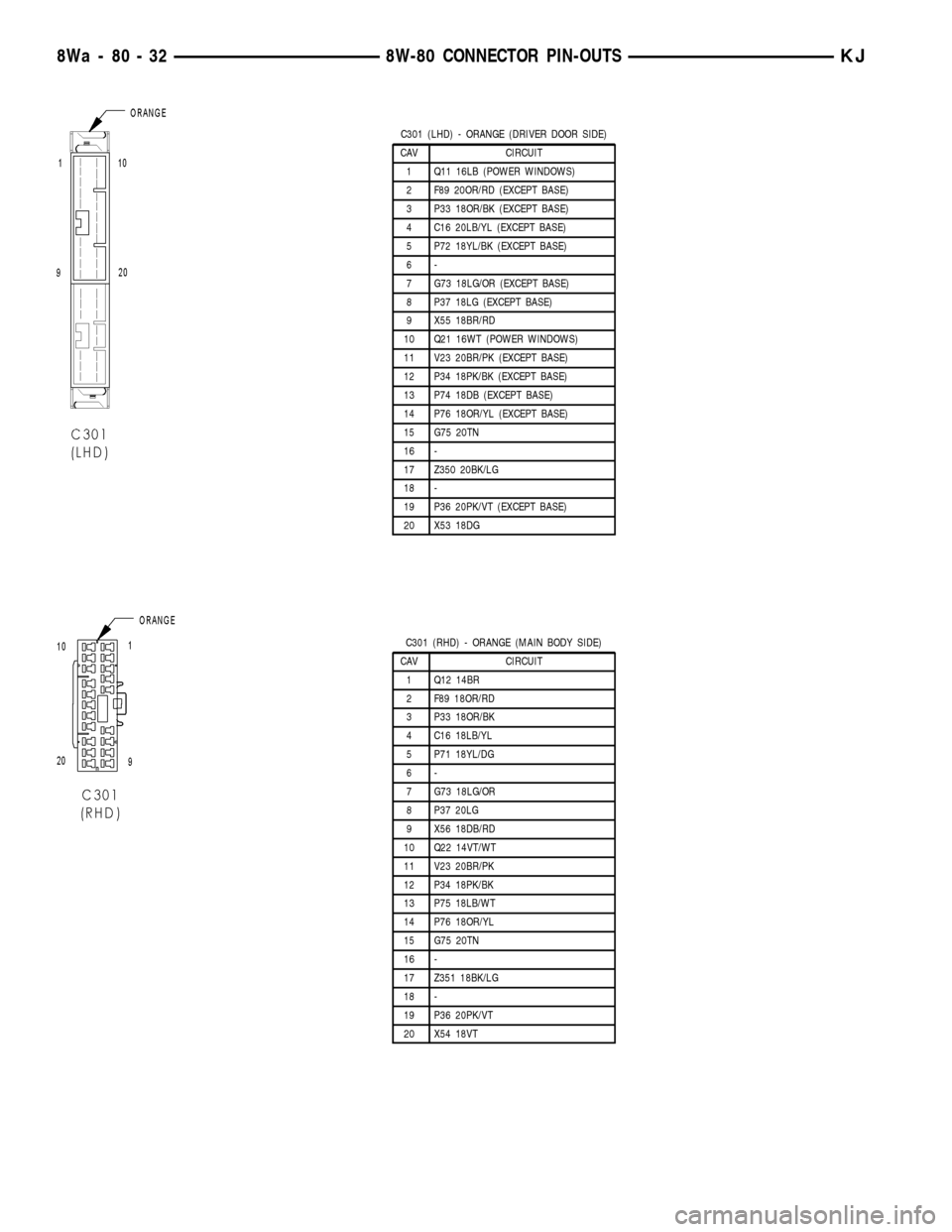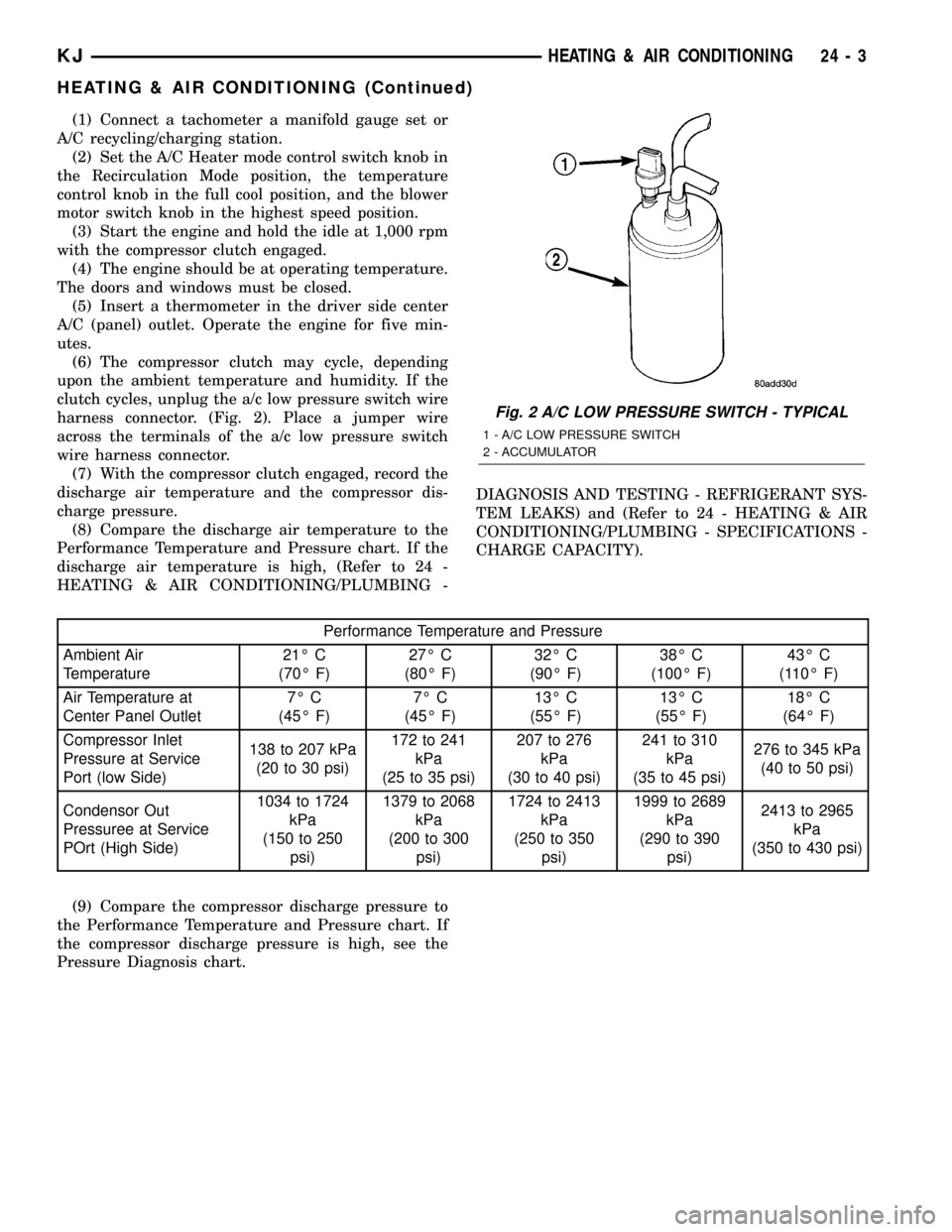2002 JEEP LIBERTY Windows
[x] Cancel search: WindowsPage 1024 of 1803

8W-60 POWER WINDOWS
Component Page
G301............................. 8Wa-60-2
Ignition Switch..................... 8Wa-60-2
Left Front Power Window Motor........ 8Wa-60-2
Left Rear Power Window Motor........ 8Wa-60-3Component Page
Power Window Master Switch........ 8Wa-60-2, 3
Rear Power Window Switch........... 8Wa-60-3
Right Front Power Window Motor....... 8Wa-60-2
Right Rear Power Window Motor....... 8Wa-60-3
KJ8W-60 POWER WINDOWS8Wa-60-1
Page 1087 of 1803

C301 (LHD) - ORANGE (DRIVER DOOR SIDE)
CAV CIRCUIT
1 Q11 16LB (POWER WINDOWS)
2 F89 20OR/RD (EXCEPT BASE)
3 P33 18OR/BK (EXCEPT BASE)
4 C16 20LB/YL (EXCEPT BASE)
5 P72 18YL/BK (EXCEPT BASE)
6-
7 G73 18LG/OR (EXCEPT BASE)
8 P37 18LG (EXCEPT BASE)
9 X55 18BR/RD
10 Q21 16WT (POWER WINDOWS)
11 V23 20BR/PK (EXCEPT BASE)
12 P34 18PK/BK (EXCEPT BASE)
13 P74 18DB (EXCEPT BASE)
14 P76 18OR/YL (EXCEPT BASE)
15 G75 20TN
16 -
17 Z350 20BK/LG
18 -
19 P36 20PK/VT (EXCEPT BASE)
20 X53 18DG
C301 (RHD) - ORANGE (MAIN BODY SIDE)
CAV CIRCUIT
1 Q12 14BR
2 F89 18OR/RD
3 P33 18OR/BK
4 C16 18LB/YL
5 P71 18YL/DG
6-
7 G73 18LG/OR
8 P37 20LG
9 X56 18DB/RD
10 Q22 14VT/WT
11 V23 20BR/PK
12 P34 18PK/BK
13 P75 18LB/WT
14 P76 18OR/YL
15 G75 20TN
16 -
17 Z351 18BK/LG
18 -
19 P36 20PK/VT
20 X54 18VT
8Wa - 80 - 32 8W-80 CONNECTOR PIN-OUTSKJ
Page 1091 of 1803

C303 (LHD) - ORANGE (PASSENGER DOOR
SIDE)
CAV CIRCUIT
1 Q12 16BR (POWER WINDOWS)
2 F89 20OR/RD (EXCEPT BASE)
3 P33 18OR/BK (EXCEPT BASE)
4 C16 20LB/YL (EXCEPT BASE)
5 P72 20YL/BK (EXCEPT BASE)
6-
7 G72 18DG/OR (EXCEPT BASE)
8 P37 18LG (EXCEPT BASE)
9 X56 18DB/RD
10 Q22 16VT/WT (POWER WINDOWS)
11 -
12 P35 18OR/VT (EXCEPT BASE)
13 P74 20DB (EXCEPT BASE)
14 P76 20OR/YL (EXCEPT BASE)
15 G74 20TN/WT
16 -
17 Z351 18BK/LG
18 -
19 P36 20PK/VT (EXCEPT BASE)
20 X54 18VT
C303 (RHD) - ORANGE (MAIN BODY SIDE)
CAV CIRCUIT
1 Q11 14LB
2 F89 18OR/RD
3 P33 18OR/BK
4 C16 18LB/YL
5 P71 18YL/DG
6-
7 G72 18DG/OR
8 P37 20LG
9 X55 18BR/RD
10 Q21 14WT
11 -
12 P35 18OR/VT
13 P75 18LB/WT
14 P76 18OR/YL
15 G74 20TN/WT
16 Z21 20BK/LG
17 Z350 18BK/LG
18 -
19 P36 20PK/VT
20 X53 18DG
8Wa - 80 - 36 8W-80 CONNECTOR PIN-OUTSKJ
Page 1407 of 1803

REMOVAL
Fuel Tank Draining
WARNING: THE FUEL SYSTEM MAY BE UNDER
CONSTANT FUEL PRESSURE EVEN WITH THE
ENGINE OFF. THIS PRESSURE MUST BE
RELEASED BEFORE SERVICING FUEL TANK.
Two different procedures may be used to drain fuel
tank: removing fuel pump module access plate, or
using DRBtscan tool. Due to a one-way check valve
installed into the fuel fill opening fitting at the tank
(Fig. 38), the tank cannot be drained conventionally
at the fill cap.
The quickest draining procedure involves removing
fuel pump module access plate.
As an alternative procedure, the electric fuel pump
may be activated allowing tank to be drained at fuel
rail connection. Refer to DRB scan tool for fuel pump
activation procedures. Before disconnecting fuel line
at fuel rail, release fuel pressure. Refer to the Fuel
System Pressure Release Procedure for procedures.
Attach end of special test hose tool number 6541,
6539, 6631 or 6923 at fuel rail disconnection (tool
number will depend on model and/or engine applica-
tion). Position opposite end of this hose tool to an
approved gasoline draining station. Activate fuel
pump and drain tank until empty.
If electric fuel pump is not operating, fuel pump
module access plate must be removed for fuel drain-
ing. Refer to following procedures.Fuel tank removal will not be necessary for
fuel tank draining. Access for draining is from
rear cargo area.
(1) Open all windows in vehicle to allow for air
ventilation.
(2) Four cargo holdown clamps are located inside
the vehicle on the floor of the rear cargo area.
Remove the 2 rearward mounted clamps by drilling
out the clamp rivets.
(3) Fold carpeting forward to gain access to fuel
pump module access plate (Fig. 39).
(4) Remove 4 fuel pump module access plate nuts
(Fig. 39).
(5) While applying heat from a heat gun, carefully
pry up fuel pump module access plate. Take care not
to bend plate.
(6) Thoroughly clean area around top of pump
module to prevent contaminants from entering fuel
tank or fuel lines.
(7) Release fuel system pressure.
(8) Disconnect 2 fuel lines (Fig. 40) at fuel pump
module by pressing on tabs at side of fitting.
(9) Disconnect electrical connector (Fig. 40). Slide
red tab first to unlock, and push grey tab down for
removal.
(10) Disconnect ORVR hose (Fig. 40) at pump mod-
ule fitting.
Fig. 38 FUEL FILL CHECK VALVE
1 - ONE-WAY CHECK VALVE
2 - FUEL FILL FITTING
3 - SIDE OF FUEL TANK
Fig. 39 ACCESS PLATE
1 - FLOORPAN AT REAR
2 - FUEL PUMP MODULE ACCESS PLATE
3 - NUTS (4)
4 - OPENING TO PUMP MODULE
KJFUEL DELIVERY 14 - 25
FUEL TANK (Continued)
Page 1467 of 1803

DIAGNOSIS AND TESTING
DIAGNOSIS AND TESTING - WATER LEAKS
Water leaks can be caused by poor sealing,
improper body component alignment, body seam
porosity, missing plugs, or blocked drain holes. Cen-
trifugal and gravitational force can cause water to
drip from a location away from the actual leak point,
making leak detection difficult. All body sealing
points should be water tight in normal wet-driving
conditions. Water flowing downward from the front of
the vehicle should not enter the passenger or luggage
compartment. Moving sealing surfaces will not
always seal water tight under all conditions. At
times, side glass or door seals will allow water to
enter the passenger compartment during high pres-
sure washing or hard driving rain (severe) condi-
tions. Overcompensating on door or glass
adjustments to stop a water leak that occurs under
severe conditions can cause premature seal wear and
excessive closing or latching effort. After completing
a repair, water test vehicle to verify leak has stopped
before returning vehicle to use.
VISUAL INSPECTION BEFORE WATER LEAK TESTS
Verify that floor and body plugs are in place, body
drains are clear, and body components are properly
aligned and sealed. If component alignment or seal-
ing is necessary, refer to the appropriate section of
this group for proper procedures.
WATER LEAK TESTS
WARNING: DO NOT USE ELECTRIC SHOP LIGHTS
OR TOOLS IN WATER TEST AREA. PERSONAL
INJURY CAN RESULT.
When the conditions causing a water leak have
been determined, simulate the conditions as closely
as possible.
²If a leak occurs with the vehicle parked in a
steady light rain, flood the leak area with an open-
ended garden hose.
²If a leak occurs while driving at highway speeds
in a steady rain, test the leak area with a reasonable
velocity stream or fan spray of water. Direct the
spray in a direction comparable to actual conditions.
²If a leak occurs when the vehicle is parked on an
incline, hoist the end or side of the vehicle to simu-
late this condition. This method can be used when
the leak occurs when the vehicle accelerates, stops or
turns. If the leak occurs on acceleration, hoist the
front of the vehicle. If the leak occurs when braking,
hoist the back of the vehicle. If the leak occurs on left
turns, hoist the left side of the vehicle. If the leak
occurs on right turns, hoist the right side of the vehi-cle. For hoisting recommendations refer to Group 0,
Lubrication and Maintenance, General Information
section.
WATER LEAK DETECTION
To detect a water leak point-of-entry, do a water
test and watch for water tracks or droplets forming
on the inside of the vehicle. If necessary, remove inte-
rior trim covers or panels to gain visual access to the
leak area. If the hose cannot be positioned without
being held, have someone help do the water test.
Some water leaks must be tested for a considerable
length of time to become apparent. When a leak
appears, find the highest point of the water track or
drop. The highest point usually will show the point of
entry. After leak point has been found, repair the
leak and water test to verify that the leak has
stopped.
Locating the entry point of water that is leaking
into a cavity between panels can be difficult. The
trapped water may splash or run from the cavity,
often at a distance from the entry point. Most water
leaks of this type become apparent after accelerating,
stopping, turning, or when on an incline.
MIRROR INSPECTION METHOD
When a leak point area is visually obstructed, use
a suitable mirror to gain visual access. A mirror can
also be used to deflect light to a limited-access area
to assist in locating a leak point.
BRIGHT LIGHT LEAK TEST METHOD
Some water leaks in the luggage compartment can
be detected without water testing. Position the vehi-
cle in a brightly lit area. From inside the darkened
luggage compartment inspect around seals and body
seams. If necessary, have a helper direct a drop light
over the suspected leak areas around the luggage
compartment. If light is visible through a normally
sealed location, water could enter through the open-
ing.
PRESSURIZED LEAK TEST METHOD
When a water leak into the passenger compart-
ment cannot be detected by water testing, pressurize
the passenger compartment and soap test exterior of
the vehicle. To pressurize the passenger compart-
ment, close all doors and windows, start engine, and
set heater control to high blower in HEAT position. If
engine can not be started, connect a charger to the
battery to ensure adequate voltage to the blower.
With interior pressurized, apply dish detergent solu-
tion to suspected leak area on the exterior of the
vehicle. Apply detergent solution with spray device or
soft bristle brush. If soap bubbles occur at a body
seam, joint, seal or gasket, the leak entry point could
be at that location.
23 - 2 BODYKJ
BODY (Continued)
Page 1655 of 1803

(1) Connect a tachometer a manifold gauge set or
A/C recycling/charging station.
(2) Set the A/C Heater mode control switch knob in
the Recirculation Mode position, the temperature
control knob in the full cool position, and the blower
motor switch knob in the highest speed position.
(3) Start the engine and hold the idle at 1,000 rpm
with the compressor clutch engaged.
(4) The engine should be at operating temperature.
The doors and windows must be closed.
(5) Insert a thermometer in the driver side center
A/C (panel) outlet. Operate the engine for five min-
utes.
(6) The compressor clutch may cycle, depending
upon the ambient temperature and humidity. If the
clutch cycles, unplug the a/c low pressure switch wire
harness connector. (Fig. 2). Place a jumper wire
across the terminals of the a/c low pressure switch
wire harness connector.
(7) With the compressor clutch engaged, record the
discharge air temperature and the compressor dis-
charge pressure.
(8) Compare the discharge air temperature to the
Performance Temperature and Pressure chart. If the
discharge air temperature is high, (Refer to 24 -
HEATING & AIR CONDITIONING/PLUMBING -DIAGNOSIS AND TESTING - REFRIGERANT SYS-
TEM LEAKS) and (Refer to 24 - HEATING & AIR
CONDITIONING/PLUMBING - SPECIFICATIONS -
CHARGE CAPACITY).
Performance Temperature and Pressure
Ambient Air
Temperature21É C
(70É F)27É C
(80É F)32É C
(90É F)38É C
(100É F)43É C
(110É F)
Air Temperature at
Center Panel Outlet7É C
(45É F)7É C
(45É F)13É C
(55É F)13É C
(55É F)18É C
(64É F)
Compressor Inlet
Pressure at Service
Port (low Side)138 to 207 kPa
(20 to 30 psi)172 to 241
kPa
(25 to 35 psi)207 to 276
kPa
(30 to 40 psi)241 to 310
kPa
(35 to 45 psi)276 to 345 kPa
(40 to 50 psi)
Condensor Out
Pressuree at Service
POrt (High Side)1034 to 1724
kPa
(150 to 250
psi)1379 to 2068
kPa
(200 to 300
psi)1724 to 2413
kPa
(250 to 350
psi)1999 to 2689
kPa
(290 to 390
psi)2413 to 2965
kPa
(350 to 430 psi)
(9) Compare the compressor discharge pressure to
the Performance Temperature and Pressure chart. If
the compressor discharge pressure is high, see the
Pressure Diagnosis chart.
Fig. 2 A/C LOW PRESSURE SWITCH - TYPICAL
1 - A/C LOW PRESSURE SWITCH
2 - ACCUMULATOR
KJHEATING & AIR CONDITIONING 24 - 3
HEATING & AIR CONDITIONING (Continued)
Page 1729 of 1803

Freeze Frame Data Storage
Once a failure occurs, the Task Manager records
several engine operating conditions and stores it in a
Freeze Frame. The Freeze Frame is considered one
frame of information taken by an on-board data
recorder. When a fault occurs, the PCM stores the
input data from various sensors so that technicians
can determine under what vehicle operating condi-
tions the failure occurred.
The data stored in Freeze Frame is usually
recorded when a system fails the first time for two
trip faults. Freeze Frame data will only be overwrit-
ten by a different fault with a higher priority.
CAUTION: Erasing DTCs, either with the DRB III or
by disconnecting the battery, also clears all Freeze
Frame data.
Similar Conditions Window
The Similar Conditions Window displays informa-
tion about engine operation during a monitor. Abso-
lute MAP (engine load) and Engine RPM are stored
in this window when a failure occurs. There are two
different Similar conditions Windows: Fuel System
and Misfire.
FUEL SYSTEM
²Fuel System Similar Conditions WindowÐ
An indicator that 'Absolute MAP When Fuel Sys Fail'
and 'RPM When Fuel Sys Failed' are all in the same
range when the failure occurred. Indicated by switch-
ing from 'NO' to 'YES'.
²Absolute MAP When Fuel Sys FailÐ The
stored MAP reading at the time of failure. Informs
the user at what engine load the failure occurred.
²Absolute MAPÐ A live reading of engine load
to aid the user in accessing the Similar Conditions
Window.
²RPM When Fuel Sys FailÐ The stored RPM
reading at the time of failure. Informs the user at
what engine RPM the failure occurred.
²Engine RPMÐ A live reading of engine RPM
to aid the user in accessing the Similar Conditions
Window.
²Adaptive Memory FactorÐ The PCM utilizes
both Short Term Compensation and Long Term Adap-
tive to calculate the Adaptive Memory Factor for
total fuel correction.
²Upstream O2S VoltsÐ A live reading of the
Oxygen Sensor to indicate its performance. For
example, stuck lean, stuck rich, etc.
²SCW Time in Window (Similar Conditions
Window Time in Window)Ð A timer used by thePCM that indicates that, after all Similar Conditions
have been met, if there has been enough good engine
running time in the SCW without failure detected.
This timer is used to increment a Good Trip.
²Fuel System Good Trip CounterÐATrip
Counter used to turn OFF the MIL for Fuel System
DTCs. To increment a Fuel System Good Trip, the
engine must be in the Similar Conditions Window,
Adaptive Memory Factor must be less than cali-
brated threshold and the Adaptive Memory Factor
must stay below that threshold for a calibrated
amount of time.
²Test Done This TripÐ Indicates that the
monitor has already been run and completed during
the current trip.
MISFIRE
²Same Misfire Warm-Up StateÐ Indicates if
the misfire occurred when the engine was warmed up
(above 160É F).
²In Similar Misfire WindowÐ An indicator
that 'Absolute MAP When Misfire Occurred' and
'RPM When Misfire Occurred' are all in the same
range when the failure occurred. Indicated by switch-
ing from 'NO' to 'YES'.
²Absolute MAP When Misfire OccurredÐ
The stored MAP reading at the time of failure.
Informs the user at what engine load the failure
occurred.
²Absolute MAPÐ A live reading of engine load
to aid the user in accessing the Similar Conditions
Window.
²RPM When Misfire OccurredÐ The stored
RPM reading at the time of failure. Informs the user
at what engine RPM the failure occurred.
²Engine RPMÐ A live reading of engine RPM
to aid the user in accessing the Similar Conditions
Window.
²Adaptive Memory FactorÐ The PCM utilizes
both Short Term Compensation and Long Term Adap-
tive to calculate the Adaptive Memory Factor for
total fuel correction.
²200 Rev CounterÐ Counts 0±100 720 degree
cycles.
²SCW Cat 200 Rev CounterÐ Counts when in
similar conditions.
²SCW FTP 1000 Rev CounterÐ Counts 0±4
when in similar conditions.
²Misfire Good Trip CounterÐ Counts up to
three to turn OFF the MIL.
²Misfire DataÐ Data collected during test.
²Test Done This TripÐ Indicates YES when the
test is done.
KJEMISSIONS CONTROL 25 - 23
EMISSIONS CONTROL (Continued)
Page 1758 of 1803

PLATE LAMP UNIT - INSTALLATION,
LICENSE...........................8L-46
PLATE LAMP UNIT - REMOVAL, LICENSE . . 8L-45
PLATES - INSTALLATION, EXTERIOR
NAME............................23-141
PLATES - REMOVAL, EXTERIOR NAME . . . 23-140
PLUG - CLEANING SPARK PLUGS,
SPARK .............................8I-15
PLUG - DESCRIPTION, SPARK...........8I-12
PLUG - INSTALLATION, SPARK..........8I-15
PLUG - OPERATION, SPARK............8I-12
PLUG - REMOVAL, SPARK..............8I-15
PLUG CABLE RESISTANCE, 2.4L - SPARK . . . 8I-3
PLUG CONDITIONS - DIAGNOSIS AND
TESTING, SPARK.....................8I-13
PLUGS - STANDARD PROCEDURE,
ENGINE CORE AND OIL GALLERY........9-10
PLUGS, SPARK PLUG - CLEANING
SPARK .............................8I-15
PLUGS, SPECIFICATIONS - SPARK........8I-3
POLISHING - DESCRIPTION, FINESSE
SANDING/BUFFING..................23-163
PORT - DESCRIPTION, REFRIGERANT
SYSTEM SERVICE.....................24-2
PORT - OPERATION, REFRIGERANT
SYSTEM SERVICE.....................24-2
POSITION LAMP BULB - INSTALLATION,
FRONT.............................8L-28
POSITION LAMP BULB - REMOVAL,
FRONT.............................8L-28
POSITION SENSOR - DESCRIPTION . 21-209,21-247
POSITION SENSOR - DESCRIPTION,
CRANKSHAFT.......................14-30
POSITION SENSOR - DESCRIPTION,
THROTTLE..........................14-47
POSITION SENSOR - INSTALLATION....21-210,
21-247
POSITION SENSOR - INSTALLATION,
CRANKSHAFT.......................14-32
POSITION SENSOR - INSTALLATION,
THROTTLE..........................14-48
POSITION SENSOR - OPERATION . 21-209,21-247
POSITION SENSOR - OPERATION,
CRANKSHAFT.......................14-31
POSITION SENSOR - OPERATION,
THROTTLE..........................14-47
POSITION SENSOR - REMOVAL . . 21-210,21-247
POSITION SENSOR - REMOVAL,
CRANKSHAFT.......................14-31
POSITION SENSOR - REMOVAL,
THROTTLE..........................14-47
POSITION SWITCH - DESCRIPTION,
CLUTCH PEDAL.......................6-11
POSITION SWITCH - DIAGNOSIS AND
TESTING, CLUTCH PEDAL...............6-11
POSITION SWITCH - OPERATION,
CLUTCH PEDAL.......................6-11
POTENTIAL - STANDARD PROCEDURE,
TESTING OF VOLTAGE..............8W-01-9
POWER BRAKE BOOSTER -
DESCRIPTION........................5-21
POWER BRAKE BOOSTER -
INSTALLATION........................5-23
POWER BRAKE BOOSTER - OPERATION . . . 5-21
POWER BRAKE BOOSTER - REMOVAL.....5-22
POWER DISTRIBUTION - DESCRIPTION . 8W-97-1
POWER DISTRIBUTION - OPERATION . . 8W-97-1
POWER DISTRIBUTION CENTER -
DESCRIPTION.....................8W-97-6
POWER DISTRIBUTION CENTER -
OPERATION.......................8W-97-7
POWER DISTRIBUTION CENTER -
REMOVAL........................8W-97-7
POWER DISTRIBUTION CENTER
ASSEMBLY, ASSEMBLY.............8W-97-10
POWER DISTRIBUTION CENTER
DISASSEMBLY, DISASSEMBLY........8W-97-7
POWER DISTRIBUTION SYSTEMS,
SPECIAL TOOLS...................8W-97-2
POWER GROUNDS - DESCRIPTION......8E-13
POWER LOCKS - DESCRIPTION
..........8N-1
POWER LOCKS - DIAGNOSIS AND
TESTING
............................8N-3
POWER LOCKS - OPERATION
............8N-3
POWER MIRROR SWITCH - DIAGNOSIS
AND TESTING
.......................8N-12
POWER MIRROR SWITCH -
INSTALLATION
......................8N-13POWER MIRROR SWITCH - REMOVAL . . . 8N-13
POWER MIRRORS - DESCRIPTION......8N-11
POWER MIRRORS - DIAGNOSIS AND
TESTING...........................8N-11
POWER MIRRORS - OPERATION........8N-11
POWER OUTLET - DESCRIPTION.....8W-97-11
POWER OUTLET - DIAGNOSIS AND
TESTING........................8W-97-11
POWER OUTLET - INSTALLATION....8W-97-13
POWER OUTLET - OPERATION.......8W-97-11
POWER OUTLET - REMOVAL........8W-97-12
POWER SEAT SWITCH - DESCRIPTION,
LEFT..............................8N-16
POWER SEAT SWITCH - DESCRIPTION,
RIGHT.............................8N-19
POWER SEAT SWITCH - DIAGNOSIS
AND TESTING, LEFT..................8N-17
POWER SEAT SWITCH - DIAGNOSIS
AND TESTING, RIGHT.................8N-19
POWER SEAT SWITCH - INSTALLATION,
LEFT..............................8N-18
POWER SEAT SWITCH - INSTALLATION,
RIGHT.............................8N-20
POWER SEAT SWITCH - OPERATION,
LEFT..............................8N-17
POWER SEAT SWITCH - OPERATION,
RIGHT.............................8N-19
POWER SEAT SWITCH - REMOVAL, LEFT . 8N-18
POWER SEAT SWITCH - REMOVAL,
RIGHT.............................8N-20
POWER SEATS - DESCRIPTION...........8N-14
POWER SEATS - DIAGNOSIS AND
TESTING...........................8N-15
POWER SEATS - OPERATION...........8N-15
POWER STEERING FLOW AND
PRESSURE - DIAGNOSIS AND
TESTING............................19-3
POWER STEERING PRESSURE SWITCH -
DESCRIPTION.......................19-22
POWER STEERING PRESSURE SWITCH -
INSTALLATION.......................19-22
POWER STEERING PRESSURE SWITCH -
OPERATION.........................19-22
POWER STEERING PRESSURE SWITCH -
REMOVAL..........................19-22
POWER STEERING PUMP - INITIAL
OPERATION - STANDARD PROCEDURE . . . 19-18
POWER STEERING PUMP, SPECIAL
TOOLS.............................19-20
POWER STEERING SYSTEM -
DIAGNOSIS AND TESTING..............19-1
POWER WINDOWS - DESCRIPTION......8N-21
POWER WINDOWS - DIAGNOSIS AND
TESTING...........................8N-21
POWER WINDOWS - OPERATION........8N-21
POWERED - STARTER MOTOR, GAS......8F-39
POWERED - TORQUE, GAS.............8F-38
POWERING SEVERAL LOADS -
STANDARD PROCEDURE, TESTING
FOR A SHORT TO GROUND ON FUSES . 8W-01-9
PRECAUTIONS - CAUTION,
REFRIGERANT HOSES/LINES/TUBES
......24-40
PRECAUTIONS - OPERATION, SERVICE
....19-5
PRECAUTIONS AND WARNINGS,
WARNING - SAFETY
...................23-1
PRECAUTIONS, WARNING -
WINDSHIELD SAFETY
................23-173
PREFERENCES - STANDARD
PROCEDURE, RKE TRANSMITTER
CUSTOMER
..........................8N-8
PRELIMINARY - DIAGNOSIS AND
TESTING
...........................21-78
PRELIMINARY CHECKS - DIAGNOSIS
AND TESTING
.........................7-3
PREPARATION - STANDARD
PROCEDURE, ENGINE GASKET
SURFACE
.............................9-9
PRESS CONTAINER - DESCRIPTION,
COOLANT RECOVERY
..................7-19
PRESS CONTAINER - OPERATION,
COOLANT RECOVERY
..................7-19
PRESSURE - DIAGNOSIS AND TESTING,
CYLINDER COMPRESSION
...............9-8
PRESSURE - DIAGNOSIS AND TESTING,
ENGINE OIL
..........................9-60
PRESSURE - DIAGNOSIS AND TESTING,
POWER STEERING FLOW
...............19-3PRESSURE BLEEDING - STANDARD
PROCEDURE..........................5-5
PRESSURE CAP - CLEANING, RADIATOR . . . 7-25
PRESSURE CAP - DESCRIPTION,
RADIATOR...........................7-25
PRESSURE CAP - DIAGNOSIS AND
TESTING, RADIATOR...................7-25
PRESSURE CAP - INSPECTION,
RADIATOR...........................7-25
PRESSURE CAP - OPERATION,
RADIATOR...........................7-25
PRESSURE HOSE - INSTALLATION.......19-21
PRESSURE HOSE - REMOVAL..........19-21
PRESSURE INDICATOR - DESCRIPTION,
LOW OIL ...........................8J-23
PRESSURE INDICATOR - OPERATION,
LOW OIL ...........................8J-23
PRESSURE LEAK DOWN TEST -
DIAGNOSIS AND TESTING, FUEL.........14-3
PRESSURE LEAKAGE - DIAGNOSIS AND
TESTING, CYLINDER COMBUSTION........9-8
PRESSURE (LP) SENSOR -
DESCRIPTION, LINE.................21-144
PRESSURE (LP) SENSOR -
INSTALLATION, LINE.................21-144
PRESSURE (LP) SENSOR - OPERATION,
LINE..............................21-144
PRESSURE (LP) SENSOR - REMOVAL,
LINE..............................21-144
PRESSURE REGULATOR - DESCRIPTION,
FUEL..............................14-13
PRESSURE REGULATOR -
INSTALLATION, FUEL...................14-14
PRESSURE REGULATOR - OPERATION,
FUEL..............................14-14
PRESSURE REGULATOR - REMOVAL,
FUEL..............................14-14
PRESSURE RELEASE - STANDARD
PROCEDURE, FUEL SYSTEM.............14-4
PRESSURE RELIEF VALVE -
DESCRIPTION, HIGH..................24-42
PRESSURE RELIEF VALVE - OPERATION,
HIGH..............................24-42
PRESSURE SENSOR/SWITCH -
DESCRIPTION, OIL....................9-65
PRESSURE SENSOR/SWITCH -
INSTALLATION, OIL....................9-65
PRESSURE SENSOR/SWITCH -
OPERATION, OIL......................9-65
PRESSURE SENSOR/SWITCH -
REMOVAL, OIL.......................9-65
PRESSURE, SPECIFICATIONS - FUEL
SYSTEM............................14-5
PRESSURE SWITCH - DESCRIPTION, A/C
HIGH..............................24-17
PRESSURE SWITCH - DESCRIPTION, A/C
LOW ..............................24-18
PRESSURE SWITCH - DESCRIPTION,
POWER STEERING...................19-22
PRESSURE SWITCH - DIAGNOSIS AND
TESTING, A/C HIGH...................24-18
PRESSURE SWITCH - DIAGNOSIS AND
TESTING, A/C LOW
...................24-19
PRESSURE SWITCH - INSTALLATION,
A/C HIGH
...........................24-18
PRESSURE SWITCH - INSTALLATION,
A/C LOW
...........................24-19
PRESSURE SWITCH - INSTALLATION,
POWER STEERING
...................19-22
PRESSURE SWITCH - OPERATION, A/C
HIGH
..............................24-18
PRESSURE SWITCH - OPERATION, A/C
LOW
..............................24-18
PRESSURE SWITCH - OPERATION,
POWER STEERING
...................19-22
PRESSURE SWITCH - REMOVAL, A/C
HIGH
..............................24-18
PRESSURE SWITCH - REMOVAL, A/C
LOW
..............................24-19
PRESSURE SWITCH - REMOVAL,
POWER STEERING
...................19-22
PRESSURE TEST - DIAGNOSIS AND
TESTING, FUEL PUMP
.................14-15
PRESSURE TEST - DIAGNOSIS AND
TESTING, HYDRAULIC
.................21-79
PRIMARY WEATHERSTRIP -
INSTALLATION, DOOR
................23-185
KJINDEX 19
Description Group-Page Description Group-Page Description Group-Page